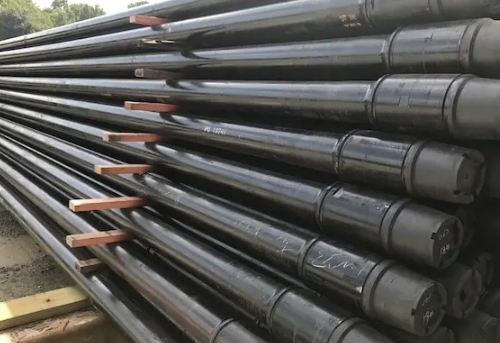
Technical Characteristics of Drill Pipes
The drill pipe is the main tool in oil and gas drilling and geological survey, and is made of seamless steel tube. Steel tubes and round bars are made into drill pipes in several processing steps. First, the end of the steel pipe is hydraulically upset by medium-frequency heating to increase the wall thickness of the pipe end. In the next step, thread processing and appropriate treatment are performed. Geological drill pipes require the joints to be connected to the drill pipe by threads, while oil drill pipes are made by friction welding the joints to the rod ends.
(1) The end of the drill pipe is heated by medium frequency, hydraulically upset, and heat treated to effectively eliminate the internal stress caused by the previous processing.
(2) The lock joint is made of 40Cr or 42CrM0 material, and is subjected to tempering heat treatment after rough machining, and surface nitriding treatment after fine machining, which can effectively prevent the problems of sticking and pulling, and is more wear-resistant and easy to disassemble.
(3) All threads are cut and formed using forming blades on CNC lathes to ensure precise fit and strong interchangeability.
The drill pipe is a steel pipe with a grooved tail, which is used to connect the surface equipment of the drilling rig and the drilling and grinding equipment or bottom hole device at the bottom of the well. The purpose of the drill pipe is to carry drilling mud to the drill bit and to raise, lower or rotate the bottom hole device together with the drill bit. The drill pipe must be able to withstand tremendous internal and external pressure, twisting, bending and vibration.

Things to note when storing drill pipes
1. Prevent foreign objects from falling in: Drill pipes stored on the construction site for a short period of time should be placed in a higher place and not buried in the muck pile. Do not allow muck, mud, water or other debris to enter the ends of the drill pipes. Do not use the drill pipes as a support to cut and weld other parts.
2. Anti-corrosion and anti-deformation: Drill pipes that are not used for a long time should be stored in a dry and ventilated warehouse. They must not come into contact with acids, alkalis and other corrosive substances, and must be protected from water erosion and fire. When stored, the outer tube should be supported horizontally to prevent the drill pipe from deforming.
3. Handling Practices: Handle pipes carefully to prevent dents, scratches, or deformation. Utilize slings, spreader bars, or forklifts to move pipes safely without causing damage.
4. Periodic Inspection: Regularly check for signs of corrosion, wear, or mechanical damage. If storing pipes long-term, periodically rotate them to ensure even aging and use.
5. Documentation: Maintain records of pipe specifications, quantities, and storage durations.Label pipes for easy identification, including size, grade, and usage history.
Read more: How to Choose and Maintain Oil Drill Pipes?


